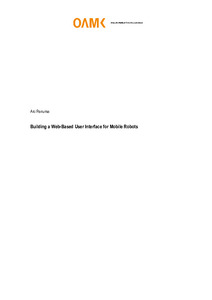Building a Web-Based User Interface for Mobile Robots
Panuma, Aki (2024)
Panuma, Aki
2024
All rights reserved. This publication is copyrighted. You may download, display and print it for Your own personal use. Commercial use is prohibited.
Julkaisun pysyvä osoite on
https://urn.fi/URN:NBN:fi:amk-202402283532
https://urn.fi/URN:NBN:fi:amk-202402283532
Tiivistelmä
The theme of this thesis was to provide a proof-of-concept web-based user interface for mobile robots, focusing on the integration of 3D graphics using Three.js within a web environment. Aimed at enhancing the control and interaction with mobile robots, the project was developed for Probot Oy, a robotics and automation company based in Oulu.
The document covers the background, objectives, methodology, and the implementation process, including planning, development, and user interaction features. It highlights the significance of 3D graphics in mobile robotics user interfaces, demonstrating through practical examples how Three.js can be effectively used to create a three-dimensional mobile robot user interface and whether Three.js is suitable for such a task. The thesis concludes with reflections on the pro-ject's success, insights gained, and future opportunities for expansion and improvement.
The project was successful, and the company gained important insight into Three.js. Producing 3D graphics and setting the scene was made easy by the vast development documentations and practical examples. The company did not have previous experience with Three.js but when com-paring technology options for this project, it was deemed the most suitable based on the available documents and the compatibility with web development guidelines and importing of 3D models.
The document covers the background, objectives, methodology, and the implementation process, including planning, development, and user interaction features. It highlights the significance of 3D graphics in mobile robotics user interfaces, demonstrating through practical examples how Three.js can be effectively used to create a three-dimensional mobile robot user interface and whether Three.js is suitable for such a task. The thesis concludes with reflections on the pro-ject's success, insights gained, and future opportunities for expansion and improvement.
The project was successful, and the company gained important insight into Three.js. Producing 3D graphics and setting the scene was made easy by the vast development documentations and practical examples. The company did not have previous experience with Three.js but when com-paring technology options for this project, it was deemed the most suitable based on the available documents and the compatibility with web development guidelines and importing of 3D models.
